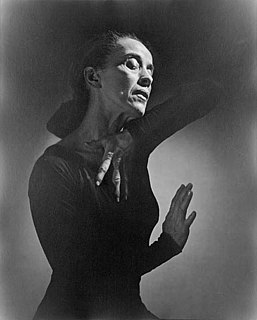Fragilité was a modern dance solo choreographed by Martha Graham to music by Alexander Scriabin. The piece was originally part of Five Poems, a ballet divided into five solo sections: Fragilité, Lugubre, Poeme ailé, Danse Languide and Désir (first performed in 1926). Each of the sections appears in various programs as individual solos. Five Poems premiered on October 16, 1927, at the Little Theatre in New York City. [1]

Martha Graham was an American modern dancer and choreographer. Her style, the Graham technique, reshaped American dance and is still taught worldwide.

Alexander Nikolayevich Scriabin was a Russian composer and pianist. Scriabin, who was influenced early in his life by the works of Frédéric Chopin, composed works that are characterised by a highly tonal idiom. Later in his career, independently of Arnold Schoenberg, Scriabin developed a substantially atonal and much more dissonant musical system, which accorded with his personal brand of mysticism. Scriabin was influenced by synesthesia, and associated colours with the various harmonic tones of his atonal scale, while his colour-coded circle of fifths was also influenced by theosophy. He is considered by some to be the main Russian Symbolist composer.

The City of New York, usually called either New York City (NYC) or simply New York (NY), is the most populous city in the United States and in the U.S. state of New York. With an estimated 2017 population of 8,622,698 distributed over a land area of about 302.6 square miles (784 km2), New York is also the most densely populated major city in the United States. Located at the southern tip of the state of New York, the city is the center of the New York metropolitan area, the largest metropolitan area in the world by urban landmass and one of the world's most populous megacities, with an estimated 20,320,876 people in its 2017 Metropolitan Statistical Area and 23,876,155 residents in its Combined Statistical Area. A global power city, New York City has been described as the cultural, financial, and media capital of the world, and exerts a significant impact upon commerce, entertainment, research, technology, education, politics, tourism, art, fashion, and sports. The city's fast pace has inspired the term New York minute. Home to the headquarters of the United Nations, New York is an important center for international diplomacy.
Other works on the program were Choral; Adagio (from second Suite); Scherzo, Op. 16 No.2; Tanzstück; Deux Valses; Danse; Tanagra; Esquisse Antique; Lucrezia; Alt-Wein; La Cancion; Ronde; Two Poems of the East and Baal Shem. Graham performed with her small company of dancers: Evelyn Sabin, Betty MacDonald and Rosina Savelli. [2]
According to Dance Magazine's critic, "Fragilité was done in a stylized transparent evening dress made of organdy, exposing enough of the body to see its outline clearly, doing justice to the title." [3] In the biography Martha, Graham's longtime friend Agnes De Mille described the solo as "an exquisite mood picture" done "in half-light, with Martha standing on an elevation of two shallow, round steps dressed in blue gauze of a moonlit translucency..." "It was a dance of such enticement, allure, promise, and evanescence as to tease and excite with the power of dreams." [4]

Dance Magazine is an influential American trade publication for dance published by the Macfadden Communications Group. It was first published in June 1927 as The American Dancer. William Como was its editor-in-chief from 1970 to his death in 1989. Wendy Perron became its editor-in-chief in 2004. Dance Magazine has multiple sister publications, including Pointe, Dance Spirit, Dance Teacher, Dance 212, and DanceU101. Dance Magazine was owned by Macfadden Communications Group from 2001 to 2016, when it was sold to Frederic M. Seegal, an investment banker with the Peter J. Solomon Company.
In a later Dance Magazine article, the piece and Graham's oeuvre were favorably reviewed. "Martha Graham is one of the pioneers of the new era, who, many of us hope will, will stay with us. I certainly hope that she keeps up her inspiring work, developing with such rapid strides as she has in the past two years. It is probably not the easiest thing on earth to create gems that remain with us and frame them for good in our memories. Among them this season were Tanagra, Fragilité, Revolt and Strike." [5]
